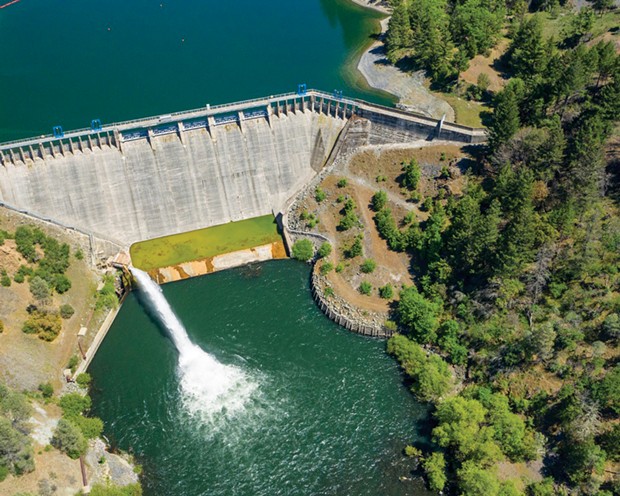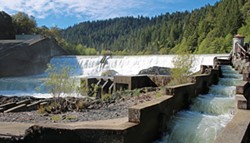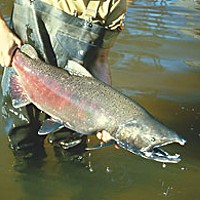PG&E Moves Forward with Eel River Dam Removal
Utility's plans have demolition starting as soon as 2028
By Thadeus Greenson [email protected] @ThadeusGreenson
Photo by Kyle Schwartz/courtesy of CalTrout
An aerial view of Scott Dam on the Eel River, which could be removed as early as 2028.
[
{
"name": "Top Stories Video Pair",
"insertPoint": "7",
"component": "17087298",
"parentWrapperClass": "fdn-ads-inline-content-block",
"requiredCountToDisplay": "1"
}
]
It now looks like two iconic North Coast rivers will flow dam free by the end of the decade.
Just weeks after the first of four dams was removed from the Klamath River as a part of what will be the largest dam removal effort in the nation's history, Pacific Gas and Electric Co. filed a 94-page surrender application to federal regulators, formalizing its plan to tear down its two dams on the Eel River that have blocked fish passage and reduced flows for more than a century.
In the filing, PG&E said deconstruction work could begin on the dams as early as 2028, pending environmental review and regulatory approval.
News of the filing was immediately celebrated by environmental and fishing groups.
"Dam removal will make the Eel the longest free-flowing river in California and will open up hundreds of miles of prime habitat unavailable to native salmon and steelhead for over 100 years," Trout Unlimited California Director Brian Johnson said in a news release. "This is the most important thing we can do for our salmon and steelhead on the Eel River, and these fisheries cannot afford to wait."
While years of drought and dwindling salmon and steelhead populations have shifted much of the focus to PG&E's Eel River dams to water, the Potter Valley project was built to provide electricity. In 1900, the Eel River Power and Irrigation Co. began construction on Cape Horn Dam on the Eel River about 4 miles north of the town of Potter Valley, creating the Van Arsdale Reservoir, as well as a 1-mile tunnel that sent Eel River water downhill through a powerhouse before releasing it to the East Fork Russian River, where it was pulled to irrigate vineyards, among other uses. But natural flows in the Eel River only allowed the project to operate in winter months, so the power company began construction in 1920 of a second, larger dam about 12 miles upriver from Cape Horn. Scott Dam, which formed Lake Pillsbury, created enough water storage capacity to control flows leading to Cape Horn, allowing the Potter Valley project to create electricity year-round.
Increasingly over recent decades, however, the project has become unviable. Endangered species protections have obligated PG&E to keep more water in the Eel River and, as diversions have decreased, so has the electricity generated. Meanwhile, upkeep and compliance costs have increased significantly, and seismic concerns surrounding Scott Dam and associated liability risks have prompted PG&E to stop filling the reservoir behind Scott Dam to capacity.
So a century after its construction, PG&E began looking to sell off the Potter Valley project to the highest bidder. After receiving no interest, the company looked to simply give it away in 2019, which launched the so-called Two Basin Partnership, a divergent group of stakeholders comprised of Sonoma County water users, Eel River environmental groups, commercial fishing organizations and others, spearheaded by North Coast Congressmember Jared Huffman. The idea would be to remove the dams but to replace them with water diversion infrastructure that would pump limited water from the Eel to Lake Mendocino when flows are high to prevent the Russian River from going dry in the summer months. But the effort has stalled largely due to the cost of the undertaking, as the environmental studies required by the Federal Energy Regulatory Commission alone are costly and the mechanics of figuring out who would fund dam removal, as well as the construction and operation of the new infrastructure needed to continue water diversions from the Eel.
The plan put forward by PG&E last week doesn't close the door on the Two Basin Solution but instead makes clear the utility is not waiting for it to materialize, and is instead moving forward with dam removal.
In a statement released after the plan's release, Huffman struck an optimistic tone as to what it would mean for his constituents in both basins.
"PG&E's draft surrender application is a major step forward to achieving the Two Basin Solution I've advocated for years," he said. "The plan includes full and expedited removal of two dams that harm salmon on the Eel River while allowing for a modern fish-friendly diversion to provide water to Mendocino, Sonoma and Marin counties. I'll be working to ensure that both elements are completed in a way that best protects communities, tribes and natural resources in the Eel and Russian River watersheds."
Craig Tucker, a consultant on the project for the county of Humboldt, said there is certainly a contingent in the environmental community inclined to say "to hell" with the Two Basin Solution, that "we're going to remove all this stuff and keep all the water." Tucker said he wouldn't go that far, but noted the complexity of coming up with a viable plan to meet both basin's needs. Plus, he said he's learned some things after decades of working for the removal of four dams on the lower Klamath River.
"If I've learned anything from the Klamath, it's keep it simple," Tucker said, adding that pushing forward as fast as possible for dam removal now wouldn't preclude a future project to help meet water demand in Sonoma County. "We feel like the fish need an immediate, full-scale restoration project if there are going to be any left."
Others who prize or depend on the Eel River feel similarly.
"These dams helped put a lot of commercial fishermen out of work," said Pacific Coast Federation of Fishermen's Associations Watershed Conservation Director Vivian Helliwell in a news release. "If we bring back the salmon, we can bring back the local food-producing jobs."
But moving forward with dam removal unquestionably is a hard reality to some. In addition to the uncertainty it creates for water users in Sonoma and Mendocino counties, undamming the Eel invariably means the loss of Lake Pillsbury, the 3.5- square-mile reservoir formed by Scott Dam. The lake is a popular recreation destination, with numerous campgrounds on its banks, as well as approximately 300 homes and cabins built in the immediate vicinity. Lake County Treasurer and Tax Collector Patrick Sullivan said in a video presentation on the subject last month that dam removal would result in annual losses of $750,000 in tax revenue for the county, as well as an immediate $40 million loss in property values. Lake County supervisors have pledged to work toward securing "monetary considerations" for affected property owners.
But on the North Coast and the lower Eel River, once one of the most prolific salmon producing rivers in the region, news that PG&E plans to move directly forward with dam removal, with construction efforts to remove Scotts Dam beginning as soon as 2028, was welcome.
"While we will listen to any creative solutions to meet the region's water needs, we will oppose anything that adversely impacts Eel River fisheries or delays dam removal," said Friends of the Eel River Executive Director Alicia Hamann in the release. "Either way you look at it, the Eel River dams' days are numbered. We prefer the most straightforward and quickest path to dam removal possible — the fish can't afford any delays."
Thadeus Greenson (he/him) is the news editor at the Journal. Reach him at (707) 442-1400, extension 321, or [email protected].
Comments (4)
Showing 1-4 of 4
more from the author
-
Man Shot by Deputy Last Month Dies
- May 8, 2024
-
CPH University Senate Calls for Independent Investigation into Protest Response
- May 7, 2024
-
Gloria DeZordo: 1926-2024
- May 5, 2024
- More »
Latest in News
Readers also liked…
-
Through Mark Larson's Lens
A local photographer's favorite images of 2022 in Humboldt
- Jan 5, 2023
-
'To Celebrate Our Sovereignty'
Yurok Tribe to host gathering honoring 'ultimate river warrior' on the anniversary of the U.S. Supreme Court ruling that changed everything
- Jun 8, 2023

































